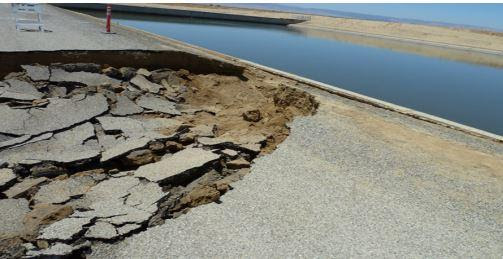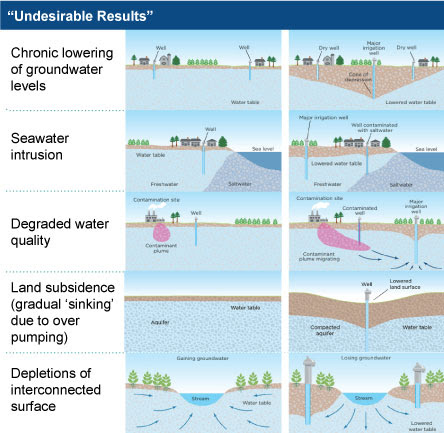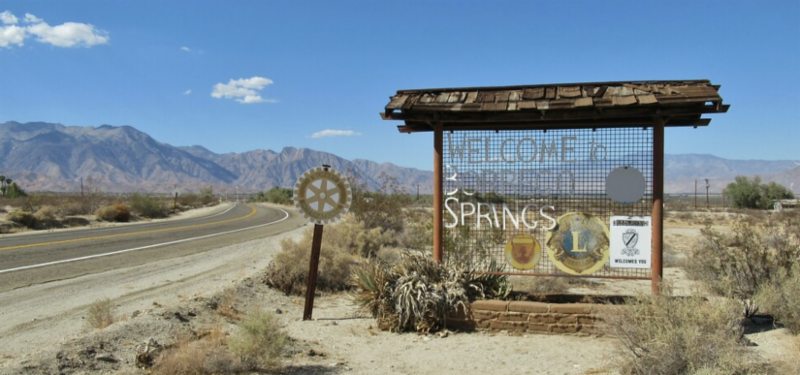June 26, 2019
Topic
All eyes were on the Borrego Valley this spring, and not just for their second “super bloom” in two years. The Borrego Valley GSA is the first in the state to release a full draft Groundwater Sustainability Plan; a new management framework required under 2014 legislation. Many are looking to the Borrego Valley GSP as a test case for the other 138 agencies currently drafting their plans, and the many stakeholders anxiously awaiting those plans.
California’s Groundwater Dependence
The new Groundwater Sustainability Plans in development are significant because California’s groundwater (that is, water naturally stored in underground soils) has long served as a “savings account” for our water supply. Some communities rely on both surface water (rivers, lakes, and streams) and groundwater supplies to meet their needs, while others are 100% groundwater dependent. Californians typically rely more heavily on groundwater in dry years, when surface water is limited. In wet years, our groundwater “savings account” can be replenished by ample precipitation increasing surface water supplies and seeping deep into the ground. However it often takes multiple wet years to make up the deficit from excessive groundwater pumping from just one dry year.
For the past 50 years California has been in a continuous trend of groundwater overdraft – pumping more groundwater than is replaced. This is predominantly due to increased agricultural, residential, and industrial development. A lack of coordination between water and land-use planning and decision-making further exacerbated this resource mismanagement. The gradual depletion of the state’s groundwater supplies hit an all-time low during the historic 2011-2017 drought. Excessive overpumping caused widespread water shortages, land subsidence, wells going dry, and water quality degradation. Some areas of the Central Valley sank by nearly 20 inches during the drought, damaging critical infrastructure and permanently reducing groundwater storage capacity.

The acute impacts felt in the earlier years of the drought provided an opportunity for landmark legislation with bipartisan and cross-sector support: the Sustainable Groundwater Management Act (SGMA). SGMA aims to ensure the long-term reliability of our groundwater and connected surface water resources. One of the hallmarks of SGMA is local control: “sustainability” is defined by recently-formed Groundwater Sustainability Agencies (GSAs), with input from community members. The local agencies create Groundwater Sustainability Plans (GSPs), with a set of goals and strategies to achieve sustainability in their groundwater basin over the next 20 years. There is also a state backstop: the State Water Resources Control Board will step in and manage the basin if the GSA fails to make adequate progress.
Groundwater Sustainability Plans: The Basics
GSAs must identify all “beneficial users” of groundwater in the GSP, which may include domestic well users, public water systems, and environmental interests. The plan must outline how these stakeholders will be impacted by implementation of the GSP, as well as describe how stakeholders will be engaged throughout the entire process. GSAs are required to actively involve diverse social, cultural, and economic interests in development and implementation of their Plan.
Groundwater sustainability is demonstrated by avoidance of six predetermined “undesirable results.” These include: surface water depletion, reduction of storage, degraded quality, seawater intrusion, land subsidence, and lowering groundwater levels.

- A description of the plan area and groundwater basin, including an assessment of current and future groundwater conditions, and a “water budget” that balances inflows and outflows.
- Sustainability goals to avoid the “undesirable results.” Each goal must outline failure points (“minimum thresholds”), goals (“measurable objectives”), and those users who will be impacted (“beneficial users”).
- Projects, programs and actions the GSAs will take to achieve the sustainability goals.
- A monitoring plan that will measure progress over time.
California’s 139 new agencies formed under SGMA are hard at work on their GSPs, which must be completed by January 2020 (for high priority basins; or 2022 for medium priority basins). Most GSAs have been releasing drafts of their GSPs one chapter at a time for stakeholders to review and comment. All eyes were on the Borrego Valley Subbasin GSA this spring, however, when they released their Draft GSP in its entirety.
The Borrego Springs Community
Nestled in the Anza-Borrego Desert of northeastern San Diego County, Borrego Springs is an unincorporated community that is 100% dependent on groundwater to sustain its agriculture and golf resort economy. The population of Borrego Springs balloons during the cooler winter months, and shrinks in the hot summer months to 3,000 permanent residents. Borrego Springs has been overdrafting its groundwater savings account for generations, to support farming and hospitality development. Now, they are faced with a drastic shift: they must reduce overall groundwater use by at least 70% to achieve sustainability.

Borrego Springs may be small, but their community members are dedicated and engaged in civic activities. The Borrego Valley Stewardship Council, for example, is a network of 17 agencies and organizations working together to make Borrego Springs “a model destination community in terms of sound economic planning, beneficial year-round tourism, world-class life-long learning, and exemplary stewardship of our cultural, social, and environmental heritage.” The work of the Stewardship Council and other local efforts over the past five years is establishing a foundation of collaborative self-governance in a community lacking more traditional agency jurisdiction.
With the passage of SGMA the Department of Water Resources designated the Borrego Springs Subbasin as a high priority, critically overdrafted basin, charged with adopting a GSP by January 2020. The County of San Diego and the Borrego Water District jointly formed the Borrego Valley GSA. The newly formed GSA, recognizing Borregans appetite for civic participation, engaged the community in the GSP development process from the outset. The Borrego Valley GSA released its draft plan with a voluntary 60-day public comment period (which is not required by the legislation). As expected, many stakeholders from within the Borrego Springs community and others from across California were eager to review the first draft GSP in the state. The GSA received 129 public comment letters from citizens, NGOs, and public agencies.
Keys to Effective Groundwater Sustainability Plan (GSP) Development
CivicWell, in partnership with the Groundwater Leadership Forum, used evaluation templates to assess the Borrego Valley GSP plan based on environmental (groundwater recharge, groundwater-dependent ecosystems, climate change considerations) and social (drinking water, equitable stakeholder engagement) criteria.
The evaluation process and the collective expertise of the Leadership Forum resulted in the following primary elements that Counties, GSAs, and community members across California should consider in reviewing GSPs for adequacy, and emphasize in public comment:
Equitable Stakeholder Engagement
Effective plans will consider all groundwater-dependent communities who may be vulnerable to impacts of groundwater management, including: domestic well owners and users; small community water systems (e.g., schools, mobile home parks); those using groundwater for drinking, cooking, and sanitary purposes; and groups reliant on interconnected surface waters (i.e. fishing, marinas, tribes).
GSAs should describe how they demonstrated adequate effort to reach all types of “beneficial user” in the GSP development process, especially historically underrepresented and/or vulnerable segments of the community. Plans should clearly identify how stakeholder input was received and addressed throughout the entire public engagement process, and how that input was integrated into the final GSP. An effective GSP stakeholder communication plan will also describe how ongoing community engagement will occur throughout the plan’s 20-year implementation period.
Drinking Water Impacts
Many Californians rely on groundwater for their drinking water needs. An effective GSP will outline how current and future groundwater quality monitoring will ensure access to safe, reliable, and affordable drinking water for all community members, including domestic well owners and users. Specifically, plans should identify wells that potentially will be impacted by increasing groundwater contamination, seawater intrusion, and/or lowering groundwater levels, as well as how mitigation efforts will be triggered if wells become compromised.
Groundwater Dependent Ecosystems
SGMA identifies groundwater-dependent ecosystems and environmental surface water as “beneficial users” that must be considered in a GSP. Effective GSPs will document current ecosystem vulnerabilities and potential impacts to those environmental interests from GSP implementation (pumping allocations and water quality monitoring in particular).
Effective GSAs will actively engage environmental stakeholders by including environmental representation on the GSA board, stakeholder advisory group, and/or technical working groups. Engaging environmental stakeholders provides GSAs the added benefit of access to additional data and resources as well as a more robust and inclusive GSP.
Climate Change Variability
SGMA regulations are short-sighted with regard to climate change impacts on groundwater resources. Water systems are already demonstrating the effects of a changing climate: warming temperatures, shrinking snowpack, changes in seasonality, and accelerated sea level rise. Effective GSAs will assess how future climate projections will impact their region’s existing water infrastructure (including surface water and groundwater storage capacity and conveyance systems).
Shorter more intense wet seasons and longer dry seasons will affect water availability and water security into the future. Resilience in the face of these changing conditions will depend on strong community and agency support for an integrated approach to land-use planning, economic development, and natural resources management.
Groundwater Recharge
A key component of groundwater sustainability is increasing recharge. Land use planning and zoning decisions have a tremendous impact on groundwater quality and recharge potential. Effective GSPs will identify optimal areas for groundwater recharge, invest in necessary infrastructure to capture more water when it’s plentiful and get it into the ground faster, and coordinate closely with local land use planning authorities to ensure recharge zones are protected.
GSAs should work with their respective Counties to update all land use planning documents to maximize recharge potential for underground storage, and streamline permitting to take advantage of capture and recharge during high flows.
Integrated Land Use / Watershed Management
Effective GSAs will consider the sustainability of current land use patterns and growth projections when establishing groundwater pumping reductions. Current land use patterns may need to shift dramatically in order to meet their sustainability goals.
Effective GSPs will evaluate and describe the community’s social and economic vulnerability relative to changes in groundwater allocations. Special attention should be paid to protecting communities that are severely disadvantaged from further burdens. Accurate vulnerability assessment is critical to protecting community members at greatest risk from groundwater impacts while pursuing a community water /land-use regime that is both economically viability and ecologically sustainable.
Looking Ahead: The 20-Year Process of SGMA Implementation
While Groundwater Sustainability Agencies in high priority basins are hard at work completing their GSPs by the 2020 deadline, and interested stakeholders are scrambling to review drafts as they’re released, it is important to remember that SGMA is an iterative, multi-decade process. GSPs are living documents; progress will be evaluated and plans updated every five years.
It is important for GSAs to genuinely engage their constituents early on and throughout the entire GSP development process. This will result in a more robust GSP with broad public support. It’s equally important for stakeholders – including public agencies impacts by GSPs – to actively engage with their GSA, and advocate for meaningful representation. Ideally, the resultant GSP will not merely meet the minimum requirements of the law, but will effectively establish all necessary land-use, water management, and community governance policies necessary to ensure a sustainable, resilient, and vibrant community.
Resources
CivicWell, in partnership with the Groundwater Leadership Forum, is developing evaluation templates to assess GSPs and the to guide community members and other stakeholders in GSP review.
- Bringing Water and Land Use Together (CivicWell)
- Regional Case Studies:
- City Of Fresno General Plan: Preserving Land for Natural Groundwater Recharge
- UC Santa Cruz: Recharge Net-Metering Pilot Program
- Borrego Valley Stewardship Council
- Regional Case Studies:
- Managing California’s Groundwater: Smart Water, Smart Planning (CivicWell)
- Getting Involved in Groundwater (Union of Concerned Scientists)
- CA Department of Water Resources SGMA Resources





